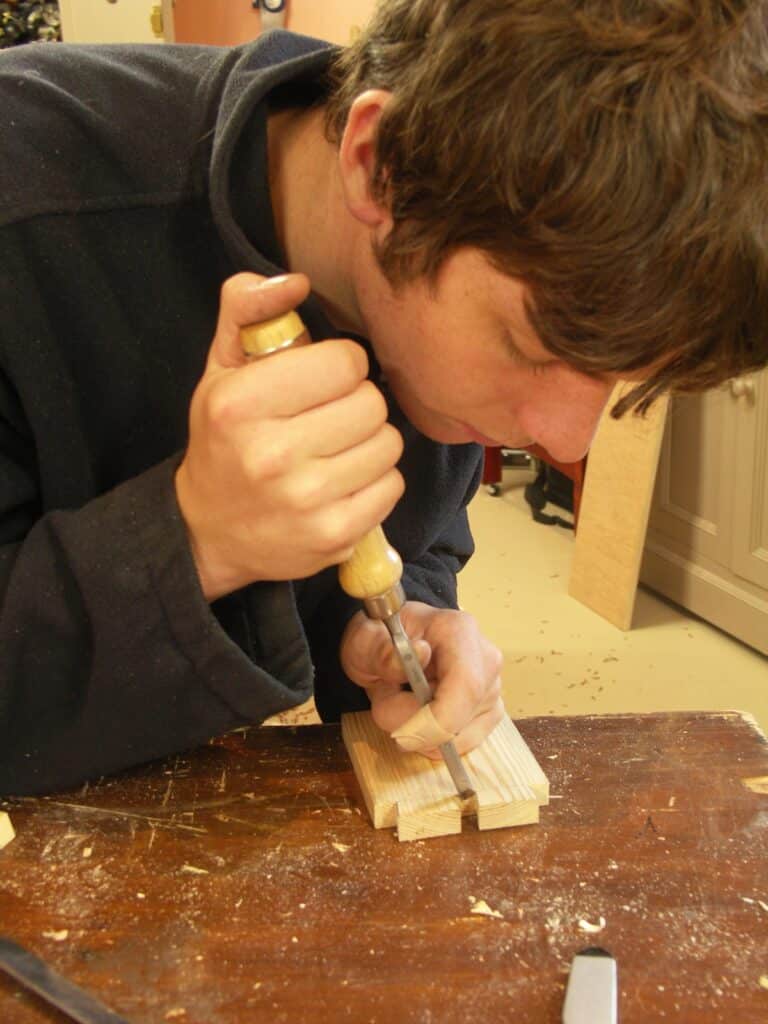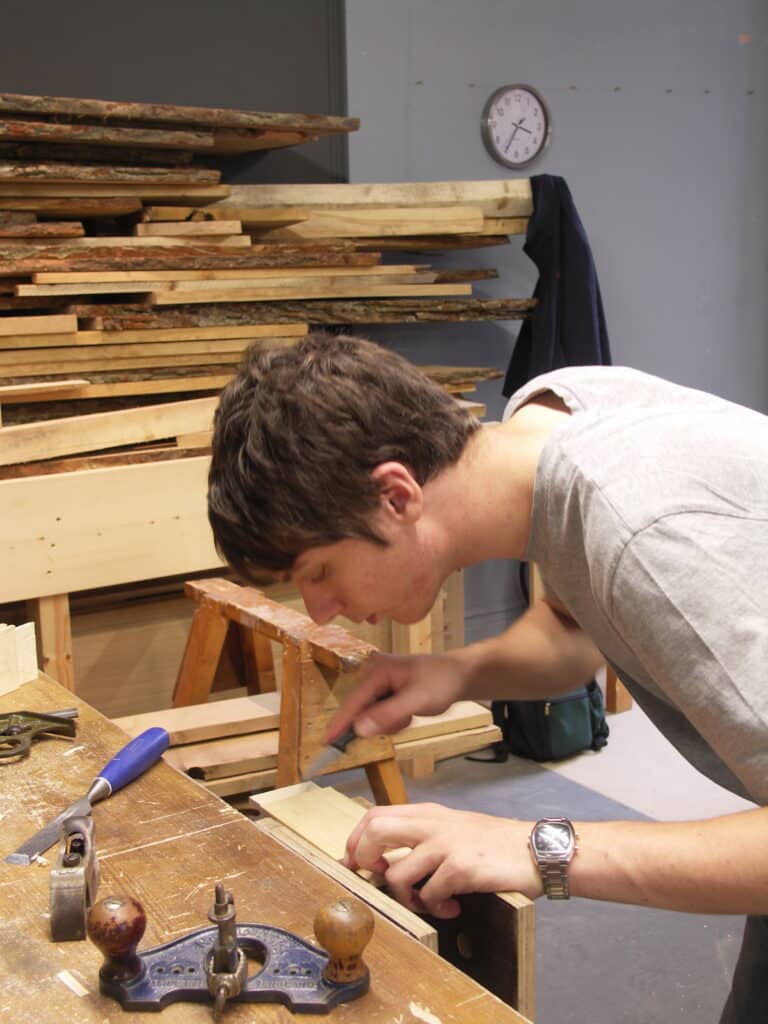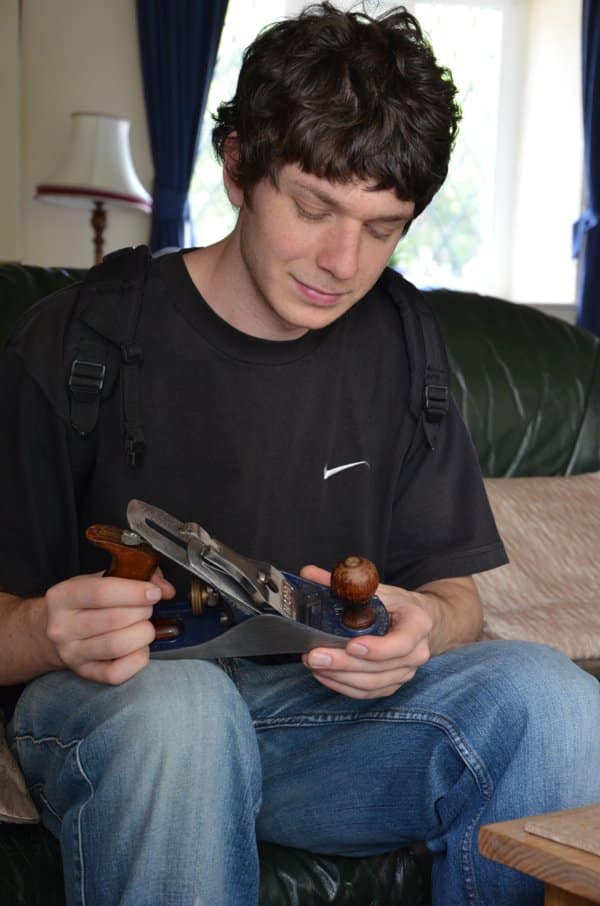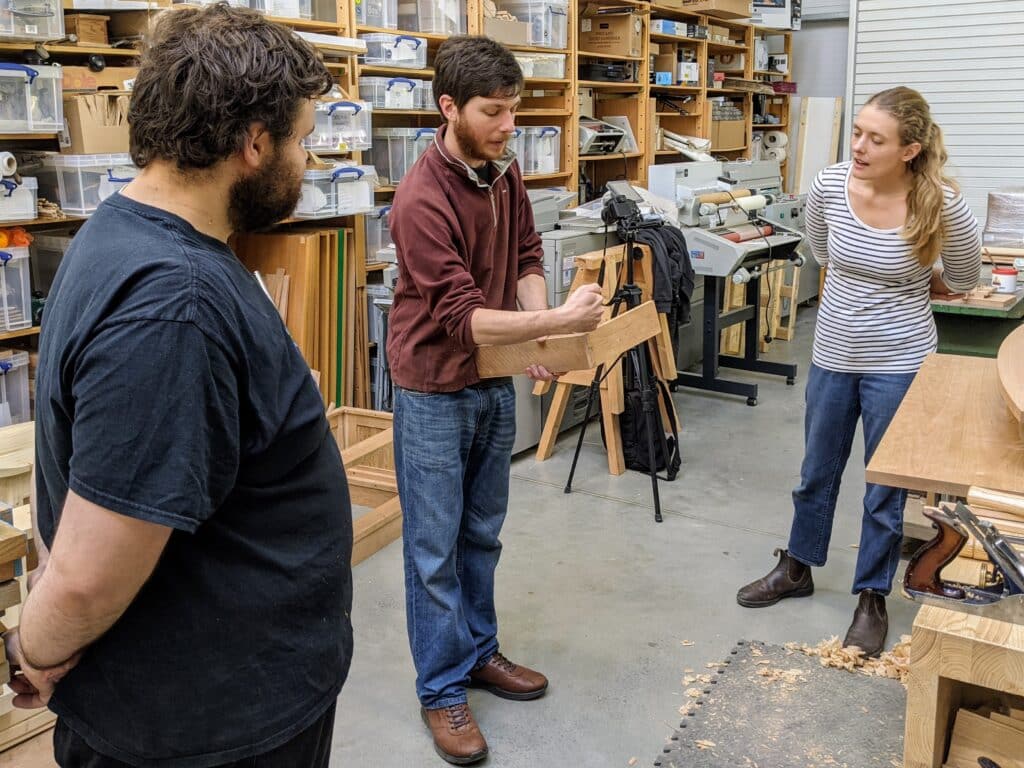Catching up with John: Part I
This is a series of posts about my apprentice John Winter who is splitting his time between starting his own furniture business and editing some past booklets as well as the revised version of my Working Wood book. I will be telling you more about John as time goes on. Usually those following along with my work are only allowed to make my designs for themselves or (on a noncommercial basis) for friends and family. I make an exception to this for those working as apprentices here in my workshop, who I allow to make and sell my designs. This is a unique opportunity to buy one of my designs made by an exceptional craftsman here in my workshop. If you want to support John’s furniture business check out his website where he has a few pieces for sale.
I can’t help but feel a little proud sometimes. There are times when you meet someone and you’re not too sure where something will lead to. You know, how some things came about despite you! People you can take on for different reasons can end up somehow depleting you for different reasons, not the least of which can be actually taking things from you that belong to you not them. Mostly this can be simply assuming rights to your stuff, maybe, as in my case once, a design you came up with, things you made and being sold by them and the money pocketed instead of going into the till. These things do happen from time to time, but then there are those who you meet who just give and give and give in all kinds of super kind ways. Now, this might seem a negative way to start a blog about a really positive happening. I did it to show that there are ways that people can reward your life.

Back in 2007, I met John Winter for the first time. It’s hard to believe 15 years have passed since then but it has. John came to do some woodworking with his dad for a few half days and they worked together to make one of my workbench designs on the driveway of my then rented home in North Wales; I was living there for just over a year when I took a sabbatical from living and working in the USA. It was a struggle for John, blisters to the palm, things like that, general fatigue from underdeveloped arm muscle, a lack of stamina. All the things I expected from a school attendee who hadn’t really been exposed to much manual work. That said, his dad, a medical doctor, had no such issues at all. He took to it quite naturally. Eventually, the bench was finished and they, both proud of their efforts, took the bench away with them. John’s father ran a clinic in Argentina but was working in the NHS in the UK for a season. It was time for the family to go back to life living in their home country once more which they did.

A few years later, John had finished high school and decided to take a gap year before pursuing a teaching qualification. He came to live with my family and work and train further with me at the workshop, which then was in Penrhyn Castle, in the form of a structured yet compacted apprenticeship. I enjoyed him being there and learning but I saw then that something had shifted. His interests in wood, tools and woodworking had really heightened exponentially. He reminded me of myself when I was young and apprenticing. He began experiencing things by experimenting with different elements of woodworking and took ownership of his findings. Taking interest in everything taught him, yes, but taking that ownership is a whole new level I have seen from time to time in different people and in my view, critical to those who want the lifestyle I so often suggest and speak of that can lead to a diversely different way of living. But John never took anything I said for granted. He wanted to know things from the inside out and this is the very ingredient I always looked for in my apprentices but did not always find it. He never stopped making and never stopped experimenting with tools, wood, etc to see just what could be performed with them. This might not seem significant but it is probably one of the most significant things in my world. Within a year, I had no qualms about him sharpening and using my personal tools. He had become experienced and I trusted him to treat the tools as I did.

The time came for him to go back to Argentina again and to continue his pursuits in physics and I would miss him for several years. After a time, John came back to learn more with me and he helped me with the hands-on classes but this time his skills and knowledge were highly refined as a capable maker. He was remarkably apt to teach too and making as he was, he also took care of the day-to-day things that supported both the school and my making. His skills and knowledge just grew and grew before he returned to Argentina once more to complete a higher degree in physics to become a teacher. A couple of years ago, John approached me yet again to see if he might join me at the workshop. I wasn’t altogether sure as we had significantly changed direction from hands-on classes to my having other apprentices alongside my online work teaching and training. I was worried that space and my time were being eaten up. My new apprentices were high-functioning autistics which I assumed all responsibility for. Taking them on to new heights was one part of my intent. How would this fit with John?

I have a follow-up post to flesh this out that I think you will enjoy.


Thanks Paul. I’m also curious about how the woodworking hands on creating has helped John in his physics. Many scientists often need to fabricate equipment to their experiments. Usually, it’s metal, electronics, and such, not wood. I think there might be some sort of cross over with the sensitivity he learned from you as a woodworker.
– Physics is about modelling the reality. It certainly help to have an hands on grip on the real world.
– There were wonderful physics instruments made from wood and brass. Visit the science museums when you have the opportunity.
I actually have a good story. When I was doing a Post Doc at Cambridge (hydrogen fuel cell on proton conducting polymers) in the UK, I needed to get a journal article that was located in one of the decentralized libraries in a physics building. I was a bit grumpy as I needed to ride my bike a bit to get there and it was just a bit inconvenient (in mid-90s though you could just start to get science articles via internet, it was expensive and still required a trip to the library. That all changed quickly). When I was there, they had a bunch of retired physics instruments on display. I wandered about looking at them. One in particular caught my eye. As I read the descriptor, it turned out to be the instrument Millikan used for his oil drop experiments that lead to determine the mass of an electron. I was floored with a deep reverence as I read this. I had always thought this was a cool experiment when I had learned about it in physics. To actually see the equipment was a privilege. I think in that one moment my whole world was reoriented that I was working at a very special university. I loved my two years there.
To this day, I am still very passionate about science. The thing is, you really can’t set up a lab easily in your garage. I’m not saying it’s impossible. Just very very difficult and limiting on what I could do even with zoning laws I would have to abide by. As such, woodworking is an awesome creative outlet for me. It has all kinds of challenges and skills and most importantly, I get to use my hands to do it.
That’s a great story. I remember very well struggling and failing to do the Millikan oil drop experiment in my first year as an undergrad. The lecturer in charge of our labs was the vaguest, most disorderly man I knew. He repeatedly dropped his sheaf of notes when lecturing and struggled to put them back in the right order. But when he had his hands on equipment he came to life amazingly. He showed me brilliantly and patiently how to adjust the electric field very sensitively. That mastery of equipment and enthusiasm about being hands-on is exactly what Paul Sellers demonstrates in a very different field. I can’t imagine Paul being anywhere near so disorganised about the ‘normal bits’ of life though!
I am very much looking forward to part 2. My son is a high functioning autistic boy and I love that you have made space for them as your apprentices.
Interesting!
Looking forward to part II.
I am a retired maths teacher and recognise the pleasure and excitement of meeting an open student prepared to work
Just imagine all the John like persons out there who are following yours and other’s videos that teach how to use hand tools to work wood.
Wonderful story Paul, looking forward to Part 2. Thank you.
Cheers
Thank you Paul for the update.
So interesting Paul, thank you very much for sharing this journey.
I look forward to hearing more.
Wood does have a place in high physics. Years back, while working at a post-graduate post at Penn State University, I was asked by one of my professors to help him create a model of the crystal structure of Barium Titanate. He wanted to make the components out of wood so that he could add articulated joints to show how the crystal structure distorts under an electric field.
I approached my father-in-law who produced production turnings for the stair building industry, but was also a fabulous hand turner and quite creative. I calculated the angles needed to produce 16 perfect octahedrons out of wood and he supplied the stock and the expertise to make the cuts. Actually, it was the very last cut that was the most difficult. Finally some of the apexes needed to be trimmed back in order to make lands for installation of the metal joints. We collaborated on that and I set up a jig to allow me to drill recesses to accept the joints.
I returned the parts back to Dr Newnham and he glued the joints in place and stained and finished the red oak model. He now had a physical model to show students how the crystal structure elastically distorts (polarizes) under an electric field which allows the structure to store electrical energy, which is the basis of capacitance in this material which is used throughout the world in chip capacitors.
Pretty cool actually.
This post warms my heart. A wonderful and life changing connection for both of you!
Potential!
Everyone possesses it.
Trees do, people do.
Some live their whole lives without an opportunity and are gradually returned to their earthly origins.
Certain trees are crafted into works of artistry or structural beauty.
Certain people find an opportunity and embrace it to make much more of their lives than those around them.
Paul Sellers, thank you for all you have crafted, designed and inspired, may you have many more trips around the Sun.
Bravo Paul and all the apprentices, including those of us operating distantly thanks to online Youtube videos. Thank you Paul and Joseph.
I didn’t think it possible, but you have risen even higher in my estimation! Would that there were enough like you to touch EVERY young person ready to excel at woodworking – and life.